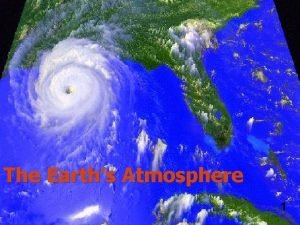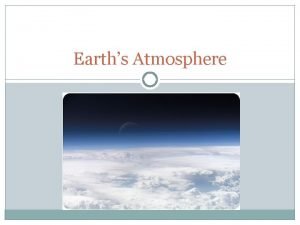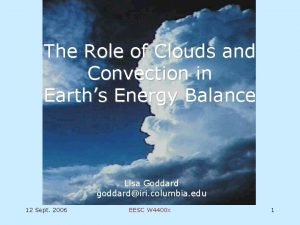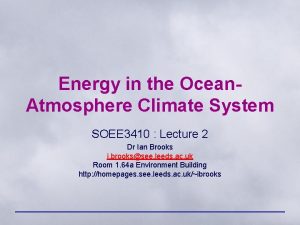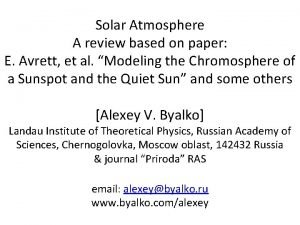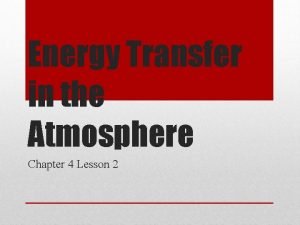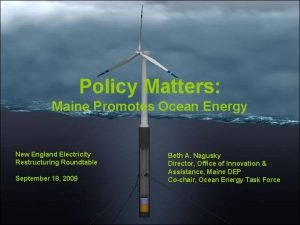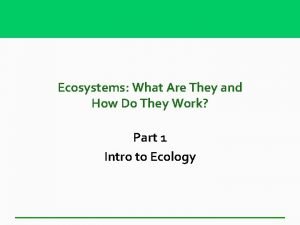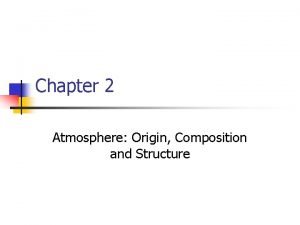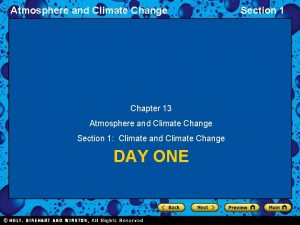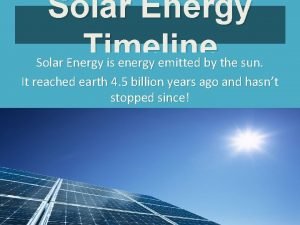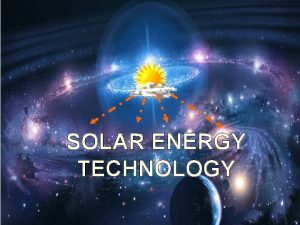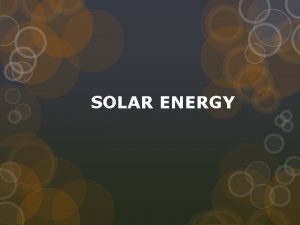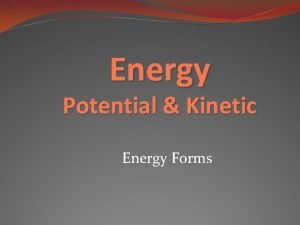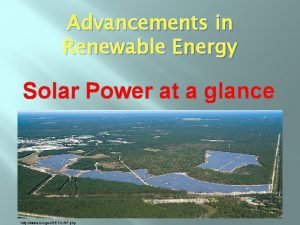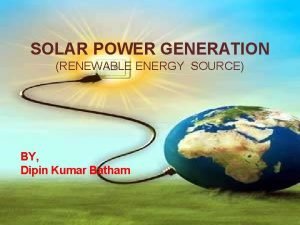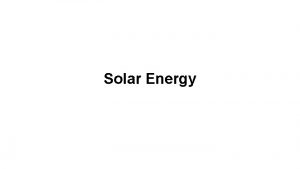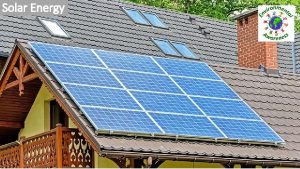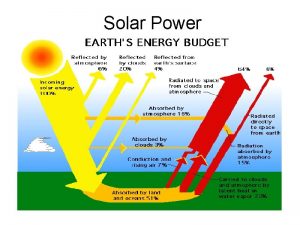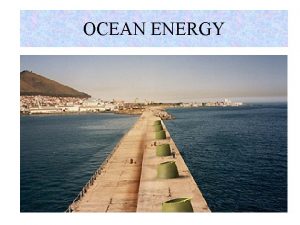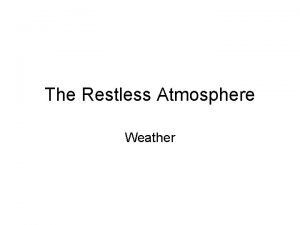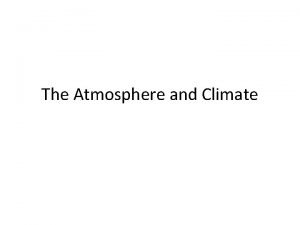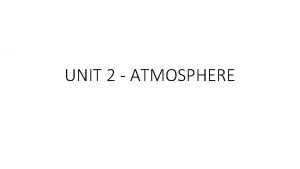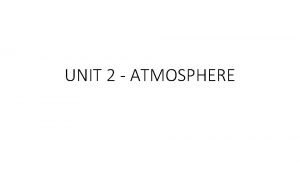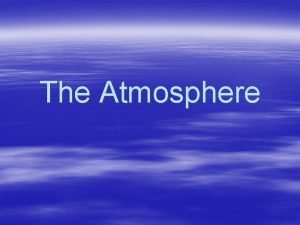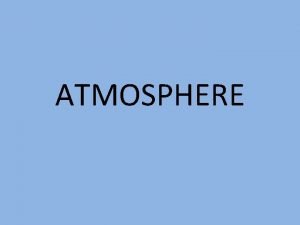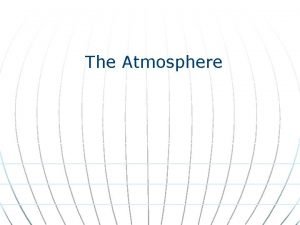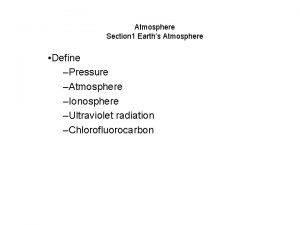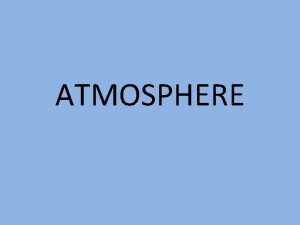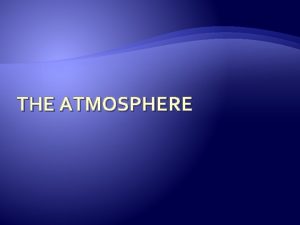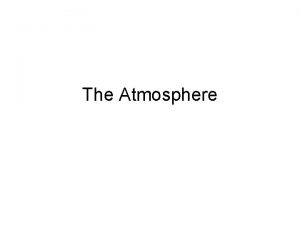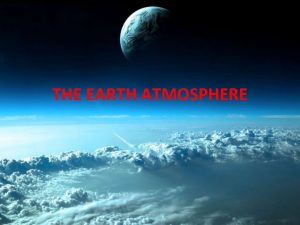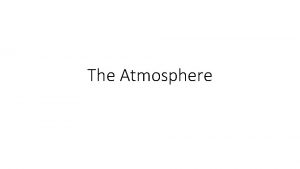Ocean Atmosphere Interactions Chapter 8 Solar Energy The




































- Slides: 36

Ocean Atmosphere Interactions Chapter 8

Solar Energy • The Sun is the Primary Source of Energy on Earth • 1400 W/m^2 at the Top of the Atmosphere • Solar energy drives the Circulation of the Atmosphere and the Ocean and the Source of Energy for almost all Living Organisms

Are Polar regions becoming colder? Are Tropical regions becoming warmer? NO! Heat is transported by atmospheric and oceanic circulations.

September 2018: 405. 51 ppm The average composition of dry air http: //co 2 now. org/ (0. 9%) (trace) (0. 039%) (20. 9%) (78. 1%) Water vapor can compose up to 4% of the atmosphere

Greenhouse effect – 1827 Fourier • Greenhouse gases: H 2 O (up to 4%), CO 2, CH 4, N 2 O, O 3, CFCs. • Greenhouse gases only absorb long-wave radiation aka radiation emitted from the earth. • Earth’s T without greenhouse gases: -18 o. C (-0. 4 o. F ) • Earth’s T with greenhouse gases: 15 o. C (59 o. F)

Greenhouse effect – 1827 Fourier • Greenhouse gases: H 2 O (up to 4%), CO 2, CH 4, N 2 O, O 3, CFCs. • Greenhouse gases only absorb long-wave radiation aka radiation emitted from the earth.

What if the earth were flat?

Solar Energy Input Varies with Latitude This ray strikes parallel to surface. Rays strike surface at angle This ray strikes perpendicular to surface. Ray strikes surface at angle This ray strikes parallel to surface.

Uneven Solar Heating – or different distribution of sunlight on earth 9

Solar Energy Input Varies with Latitude

Solar Energy Input Varies with Latitude This ray strikes parallel to surface. Rays strike surface at angle This ray strikes perpendicular to surface. Ray strikes surface at angle This ray strikes parallel to surface.

Spring (sun aims Winter (Northern Hemisphere tilts 23½ ° away from sun) directly at equator) To Polaris Summer (Northern Hemisphere tilts toward sun) Fall (sun aims directly at equator) Figure 8 -8 p 233

Albedo (aka – sunlight) The fraction of incident electromagnetic radiation reflected by a surface. High Albedo Low Albedo 13

Does loss of Arctic Sea Ice – lower or raise the earth’s albedo? Why does it matter?

Albedo – 0– 100% Reflectivity of a surface Average for Earth is 30% High latitudes – more heat lost than gained Ice has high albedo Low solar ray incidence Low latitudes – more heat gained than lost

Temperature Variation in the Atmosphere • Troposphere – lowest layer of atmosphere – Where all weather occurs – Temperature decreases with altitude – Extends from surface to about 12 km (7 miles) up

Density variation in the atmosphere: Heat Rises! – so warm air rises…. Cold air – dense sinks! Generally Warm air – more water vapor Cold air – less water vapor

Where is it wet? Where is it more dry?

Physical properties of the atmosphere: Pressure • A column of cool, dense air causes high pressure at the surface, which will lead to sinking air • A column of warm, less dense air causes low pressure at the surface, which will lead to rising air High Pressure Low Pressure

Air always flows from high to low pressure. Wind – moving air

Convection Currents

Non-rotating earth…. • Fictional nonspinning Earth • Air rises at equator (low pressure) • Air sinks at poles (high pressure) • Air flows from high to low pressure

A point on the Equator has farther to travel in a day. (bc it’s wider) Our planet rotates to the east

The Coriolis effect on Earth • As Earth rotates, different latitudes travel at different speeds • The change in speed with latitude causes the Coriolis effect

–Causes moving objects to follow curved paths: • In Northern Hemisphere, curvature is to right • In Southern Hemisphere, curvature is to left –Changes with latitude: • No Coriolis effect at Equator • Maximum Coriolis effect at poles

The Coriolis effect

Coriolis video:

Coriolis Recap: • Zero at equator • Greatest at poles • Change in Earth’s rotating velocity with latitude – 0 km/hour at poles – More than 1600 km/hour (1000 miles/hour) at equator • Greatest effect on objects that move long distances across latitudes (from North to South)

Air cools as it rises, moisture condenses and falls as rain Intense radiation at the equator warms the air Warm air rises, collecting moisture Lots of rain in the tropics! From Steve Hart, NASU

Rising air is now dry… some of the rising air flows north some of the rising air flows south Dry air descends at around 30º N Deserts …and at around 30º S The descending air flows N and S Deserts From Steve Hart, NASU

These are called circulation cells – the basic units of Vertical atmospheric circulation Circulation patterns repeat at 30 -60º and 60 -90º… Dry Moist Dry Hadley cells Wet Dry Moist Dry From Steve Hart, NASU

Subtropical High also called horse latitudes

Seasonal Changes in the Position of the Intertropical Convergence Zone (ITCZ)

Monsoons, Sea Breezes, and Land Breezes January July

The Flow of Air in Coastal Regions During Stable Weather Conditions

The Flow of Air in Coastal Regions During Stable Weather Conditions
 Troposphere facts
Troposphere facts Solar energy and the atmosphere
Solar energy and the atmosphere What is an inexhaustible source of energy
What is an inexhaustible source of energy Chapter 15 ocean water and ocean life answer key
Chapter 15 ocean water and ocean life answer key Atmosphere ocean
Atmosphere ocean Ocean atmosphere and climate
Ocean atmosphere and climate Ocean atmosphere and climate
Ocean atmosphere and climate Solar atmosphere
Solar atmosphere Indirect forms of solar energy
Indirect forms of solar energy Convergent boundary
Convergent boundary Ocean ocean convergent boundary
Ocean ocean convergent boundary Convergent boundary
Convergent boundary Ocean ocean convergent boundary
Ocean ocean convergent boundary Seafloor spreading demonstration
Seafloor spreading demonstration Ocean to ocean convergent boundary
Ocean to ocean convergent boundary Blue ocean strategy canvas
Blue ocean strategy canvas Www.wholesalesolar.com
Www.wholesalesolar.com Chapter 22 reaching out cross-cultural interactions
Chapter 22 reaching out cross-cultural interactions Chapter 22 reaching out cross-cultural interactions
Chapter 22 reaching out cross-cultural interactions Chapter 22 reaching out cross-cultural interactions
Chapter 22 reaching out cross-cultural interactions 6.1 habitats niches and species interactions
6.1 habitats niches and species interactions Which of the following tells you population density
Which of the following tells you population density Lesson 2 energy transfer in the atmosphere
Lesson 2 energy transfer in the atmosphere Energy energy transfer and general energy analysis
Energy energy transfer and general energy analysis Energy energy transfer and general energy analysis
Energy energy transfer and general energy analysis Maine wind
Maine wind What is the role of decomposers in the ecosystem?
What is the role of decomposers in the ecosystem? Atmosphere chapter 2
Atmosphere chapter 2 Atmosphere
Atmosphere Chapter 13 atmosphere and climate change
Chapter 13 atmosphere and climate change Timeline of solar energy
Timeline of solar energy Solar energy syllabus
Solar energy syllabus Solar energy is radiant light and heat from the sun
Solar energy is radiant light and heat from the sun Examples of mechanical energy
Examples of mechanical energy Avi solar energy pvt ltd
Avi solar energy pvt ltd Advancements in solar energy
Advancements in solar energy Conclusion of renewable energy
Conclusion of renewable energy
